LG G-CS1612W, FG1612H2W Owner’s Manual

OWNER'S MANUAL
WASHING
MACHINE
Before beginning installation, read these instructions carefully. This will simplify installation and ensure that the product is installed correctly and safely. Leave these instructions near the product after installation for future reference.
EN ENGLISH
FG1612H2W
1463-2556 
 1389-2559
1389-2559
www.lg.com
MFL69475570 |
Copyright © 2017-2019 LG Electronics Inc. All Rights Reserved. |
|
Rev.06_053019 |
||
|

TABLE OF CONTENTS
This manual may contain images or content different from the model you purchased.
This manual is subject to revision by the manufacturer.
SAFETY INSTRUCTIONS........................................................ |
4 |
IMPORTANT SAFETY INSTRUCTIONS.................................................... |
4 |
INSTALLATION....................................................................... |
10 |
Parts.......................................................................................................... |
10 |
Accessories............................................................................................... |
10 |
Specifications............................................................................................. |
11 |
Installation Place Requirements................................................................ |
12 |
Unpacking and Removing Transit Bolts.................................................... |
13 |
Using Anti-Slip Sheets (Optional).............................................................. |
14 |
Wooden Floors (Suspended Floors)......................................................... |
14 |
Leveling the Appliance.............................................................................. |
15 |
Connecting the Water Supply Hose.......................................................... |
15 |
Installing the Drain Hose........................................................................... |
18 |
OPERATION............................................................................ |
19 |
Using the Washing Machine...................................................................... |
19 |
Sorting Laundry......................................................................................... |
20 |
Adding Cleaning Products......................................................................... |
21 |
Control Panel............................................................................................ |
23 |
Programme Table...................................................................................... |
24 |
Option Programme.................................................................................... |
29 |
Dry ( )................................................................................................... |
33 |
SMART FUNCTIONS.............................................................. |
35 |
Using Smart ThinQ Application................................................................. |
35 |
Using Smart Diagnosis™.......................................................................... |
37 |
MAINTENANCE...................................................................... |
38 |
Cleaning Your Washing Machine.............................................................. |
38 |
Cleaning the Water Inlet Filter................................................................... |
38 |
Cleaning the Drain Pump Filter................................................................. |
39 |
Cleaning the Dispenser Drawer................................................................ |
40 |
Tub Clean (Optional)................................................................................. |
40 |
Caution on Freezing During Winter........................................................... |
41 |
TROUBLESHOOTING............................................................ |
43 |
Diagnosing Problems................................................................................ |
43 |
Error Messages......................................................................................... |
46 |
WARRANTY............................................................................ |
48 |
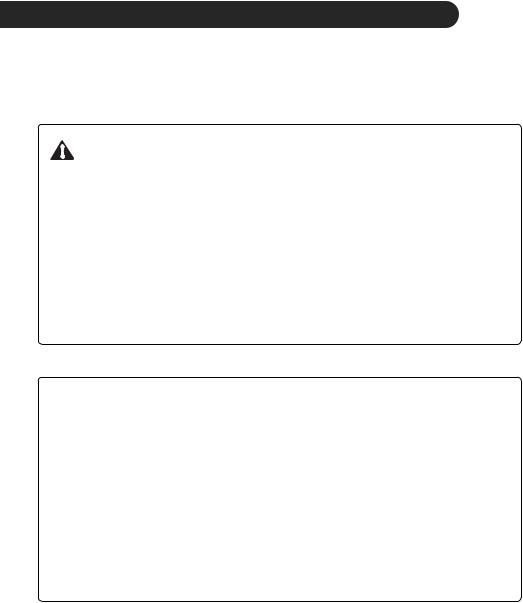
SAFETY INSTRUCTIONS
EN
The following safety guidelines are intended to prevent unforeseen risks or damage from unsafe or incorrect operation of the appliance.
The guidelines are separated into ‘WARNING’ and ‘CAUTION’ as described below.
This symbol is displayed to indicate matters and
operations that can cause risk. Read the part with this symbol carefully and follow the instructions in order to avoid risk.
 WARNING
WARNING
This indicates that the failure to follow the instructions can cause serious injury or death.
 CAUTION
CAUTION
This indicates that the failure to follow the instructions can cause the minor injury or damage to the product.
IMPORTANT SAFETY INSTRUCTIONS
 WARNING
WARNING
To reduce the risk of explosion, fire, death, electric shock, injury or scalding to persons when using this product, follow basic precautions, including the following:
Children in the Household
This appliance is not intended for use by persons (including children) with reduced physical, sensory or mental capabilities, or lack of experience and knowledge, unless they have been given supervision or instruction concerning use of the appliance by a person responsible for their safety. Children should be supervised to ensure that they do not play with the appliance.
4

EN
For use in Europe:
This appliance can be used by children aged from 8 years and above and persons with reduced physical, sensory or mental capabilities or lack of experience and knowledge if they have been given supervision or instruction concerning use of the appliance in a safe way and understand the hazards involved. Children shall not play with the appliance. Cleaning and user maintenance shall not be made by children without supervision.
Children of less than 3 years should be kept away unless continuously supervised.
Installation
••Never attempt to operate the appliance if it is damaged, malfunctioning, partially disassembled, or has missing or broken parts, including a damaged cord or plug.
••This appliance should only be transported by two or more people holding the appliance securely.
••Do not install the appliance in a damp and dusty place. Do not install or store the appliance in any outdoor area, or any area that is subject to weathering conditions such as direct sunlight, wind, or rain or temperatures below freezing.
••Tighten the drain hose to avoid separation.
••If the power cord is damaged or the hole of the socket outlet is loose, do not use the power cord and contact an authorized service centre.
••Do not plug multiple socket outlets, an extension power cable or adapter with this appliance.
5

EN
••This appliance must not be installed behind a lockable door, a sliding door or a door with a hinge on the opposite side to that of the appliance, in such a way that a full opening of the appliance door is restricted.
••This appliance must be grounded. In the event of malfunction or breakdown, grounding will reduce the risk of electric shock by providing a path of least resistance for electric current.
••This appliance is equipped with a power cord having an equipmentgrounding conductor and a grounding power plug. The power plug must be plugged into an appropriate socket outlet that is installed and grounded in accordance with all local codes and ordinances.
••Improper connection of the equipment-grounding conductor can result in risk of electric shock. Check with a qualified electrician or service personnel if you are in doubt as to whether the appliance is properly grounded.
••Do not modify the power plug provided with the appliance. If it does not fit the outlet, have a proper outlet installed by a qualified electrician.
Operation
••Do not attempt to separate any panels or disassemble the appliance. Do not apply any sharp objects to the control panel in order to operate the appliance.
••Do not repair or replace any part of the appliance. All repairs and servicing must be performed by qualified service personnel
unless specifically recommended in this Owner’s Manual. Use only authorized factory parts.
6

EN
••Do not put animals, such as pets into the appliance.
••Keep the area underneath and around the appliance free of combustible materials such as lint, paper, rags, chemicals, etc.
••Do not leave the appliance door open. Children may hang on the door or crawl inside the appliance, causing damage or injury.
••Use new hose or hose-set supplied with the appliance. Reusing old hoses can cause a water leak and subsequent property damage.
••Do not put in, wash or dry articles that have been cleaned in, washed in, soaked in, or spotted with combustible or explosive substances (such as waxes, wax removers, oil, paint, gasoline, degreasers, drycleaning solvents, kerosene, petrol, spot removers, turpentine, vegetable oil, cooking oil, acetone, alcohol, etc.). Improper use can cause fire or explosion.
••Never reach into the appliance while it is operating. Wait until the drum has completely stopped.
••In case of flood, disconnect the power plug and contact the LG Electronics customer information centre.
••Do not push down the door excessively, when the appliance door is open.
••Do not touch the door during a high temperature programme.
••Do not use flammable gas and combustible substances (benzene, gasoline, thinner, petroleum, alcohol, etc.) near the appliance.
••If the drain hose or inlet hose is frozen during winter, use it only after thawing.
••Keep all washing detergents, softener and bleach away from children.
7

EN
••Do not touch the power plug or the appliance controls with wet hands.
••Do not bend the power cable excessively or place a heavy object on it.
••Do not wash rugs, mats, shoes or pet blankets, or any other items other than clothes or sheets, in this machine.
••This appliance must only be used for domestic household purposes and should not be used in mobile applications.
••If there is a gas leakage (isobutane, propane, natural gas, etc.), do not touch the appliance or power plug and ventilate the area immediately.
Technical Safety for Using the Dryer
••Do not dry unwashed items in the appliance.
••Items that have been soiled with substances such as cooking oil, vegetable oil, acetone, alcohol, petroleum, kerosene, spot
removers, turpentine, waxes and wax removers should be washed in hot water with an extra amount of detergent before being dried in the appliance.
••Never stop the appliance before the end of the drying cycle unless all items are quickly removed and spread out so that the heat is dissipated.
••Items such as foam rubber (latex foam), shower caps, waterproof textiles, rubber backed articles and clothes or pillows fitted with foam rubber pads should not be dried in the appliance.
••Fabric softeners, or similar products, should be used as specified by the fabric softener instructions.
••Remove all objects from pockets such as lighters and matches.
••The appliance is not to be used if industrial chemicals have been used for cleaning.
8

EN
Maintenance
••Securely plug the power plug in the socket outlet after completely removing any moisture and dust.
••Disconnect the appliance from the power supply before cleaning the appliance. Setting the controls to the OFF or stand by position does not disconnect this appliance from the power supply.
••Do not spray water inside or outside the appliance to clean it.
••Never unplug the appliance by pulling on the power cable. Always grip the power plug firmly and pull straight out from the socket outlet.
Disposal
••Before discarding an old appliance, unplug it. Cut off the cable directly behind the appliance to prevent misuse.
••Dispose of all packaging materials (such as plastic bags and styrofoam) away from children. The packaging materials can cause suffocation.
••Remove the door before disposing of or discarding this appliance to avoid the danger of children or small animals getting trapped inside.
9
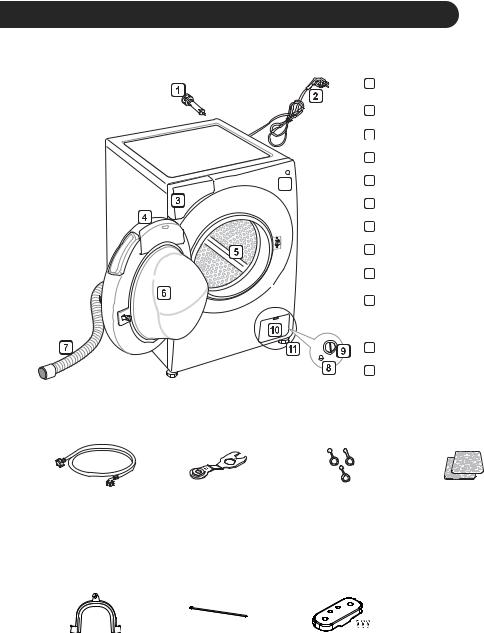
INSTALLATION
Parts
EN
1 Transit bolts
2 Power plug
3 Drawer
4Control panel
12 |
5 Drum |
6Door
7Drain hose
8 Drain plug
9Drain pump filter
Cover cap (Location may
10 vary depending on products)
11 Adjustable feet
12 Power button
Accessories
Cold supply hose (1 EA) |
Spanner |
Caps for covering |
Anti–slip sheets (2 EA) |
(Option: Hot (1 EA)) |
|
transit bolt holes |
(Optional) |
Caution |
|
(Optional) |
|
|
|
|
••Need to use Detachable Hose-sets which come with the new product only. (Do not use the used Detachable Hose-sets)
••Don’t connect hot water because this washing machine don’t design for hot water usage.
Elbow bracket for |
Tie strap (Optional) |
Stacking holder, |
securing drain hose |
|
Screws (3 EA) |
(Optional) |
|
(Optional)* |
••* : Save these accessories for future use. These accessories will be used for stacking with Pedestal washing machine. Refer to the owner’s manual for Pedestal washing machine for Installation.
10

EN
Specifications
Model |
FG1612H2W |
Wash Capacity |
12 kg (Wash) / 8 kg (Dry) |
Power Supply |
220 V~, 50 Hz |
Size |
600 mm (W) x 610 mm (D) x 850 mm (H) |
Product Weight |
76 kg |
Permissible Water pressure |
0.1 - 1.0 MPa (1.0 - 10.0 kgf / cm²) |
••Appearance and specifications may change without notice to improve the quality of the product.
••No further backflow protection required for connection to the water supply.
11
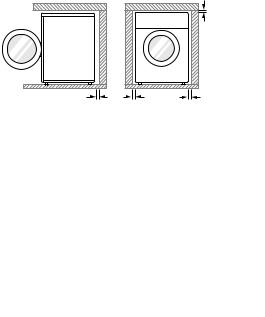
Installation Place
Requirements
Location
0.5 cm |
10 cm |
2 cm |
2 cm |
Level floor : Allowable slope under the entire appliance is 1°.
Power outlet : Must be within 1 meter of either side of the location of the appliance.
••Do not overload the outlet with more than one appliance.
Additional Clearance : For the wall, 10 cm: rear/2 cm: right & left side
••Do not place or store laundry products on top of the appliance at any time. These products may damage the finish or controls.
 WARNING
WARNING
••The plug must be plugged into an appropriate outlet that is properly installed and grounded in accordance with all local codes and ordinances.
Positioning
••Install the appliance on a flat hard floor.
••Make sure that air circulation around the appliance is not impeded by carpets, rugs, etc.
••Never try to correct any unevenness in the floor with pieces of wood, cardboard or similar materials under the appliance.
EN
••If it is impossible to avoid positioning the appliance next to a gas cooker or coal burning stove, an insulation (85x60 cm) covered with aluminum foil on the side facing the cooker
or stove must be inserted between the two appliances.
••Do not install the appliance in rooms where freezing temperatures may occur. Frozen hoses may burst under pressure. The reliability of the electronic control unit may be impaired at temperatures below freezing point.
••Ensure that when the appliance is installed, it is easily accessible for an engineer in the event of a breakdown.
••With the appliance installed, adjust all four feet using the transit bolt spanner provided to
ensure the appliance is stable, and a clearance of approximately 5 mm is left between the
top of the appliance and the underside of any worktop
••If the appliance is delivered in winter and temperatures are below freezing, place the appliance at room temperature for a few hours before putting it into operation.
 WARNING
WARNING
••This equipment is not designed for maritime use or for use in mobile installations such as caravans, aircraft etc.
Electrical Connection
••Do not use an extension cord or double adapter.
••Always unplug the appliance and turn off the water supply after use.
••Connect the appliance to an earthed socket in accordance with current wiring regulations.
••The appliance must be positioned so that the plug is easily accessible.
••Repairs to the appliance must only be carried out by qualified personnel. Repairs carried out by inexperienced persons may cause injury or serious malfunctioning. Contact your local service centre.
12
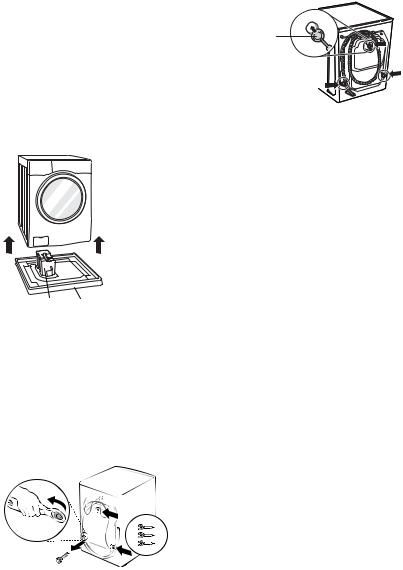
Unpacking and Removing
Transit Bolts
1 Lift the appliance off the foam base.
••After removing the carton and shipping material, lift the appliance off the foam base. Make sure the tub support comes off with the base and is not stuck to the bottom of the appliance.
••If you must lay the appliance down to remove the carton base, always protect the side of the appliance and lay it carefully on its side. Do not lay the appliance on its front or back.
Tub Support Carton (Optional) base
2 Remove the bolt assemblies.
••Starting with the bottom two transit bolts, use the spanner (included) to fully loosen all transit bolts by turning them counterclockwise. Remove the bolt
assemblies by wiggling them slightly while pulling them out.
EN
3 Install the hole caps.
••Locate the hole caps included in the accessory pack or attached on the back.
Cap
NOTE
••Save the bolt assemblies for future use. To prevent damage to internal components, Do not transport the washing machine without reinstalling the transit bolts.
••Failure to remove transit bolts and retainers may cause severe vibration and noise, which can lead to permanent damage to the washing machine. The cord is secured to the back of the washing machine with a transit bolt to help prevent operation with transit bolts in place.
13
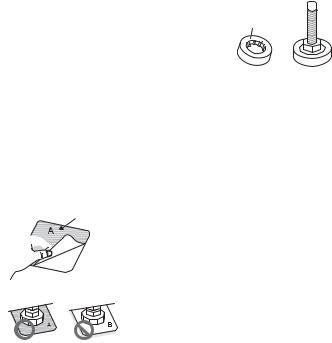
Using Anti-Slip Sheets (Optional)
If you install the appliance on a slippery surface, it may move because of excessive vibration. Incorrect leveling may cause malfunction through noise and vibration. If this occurs, install the anti-slip sheets under the leveling feet and adjust the level.
1 Clean the floor to attach the anti-slip sheets.
••Use a dry rag to remove and clean foreign objects and moisture. If moisture remains, the anti-slip sheets may slip.
2 Adjust the level after placing the appliance in the installation area.
3 Place the adhesive side of the anti-slip sheets on the floor.
••It is most effective to install the anti-slip sheets under the front legs. If it is difficult to place the pads under the front legs, place them under the back legs.
This side up


 Adhesive side
Adhesive side
4 Ensure the appliance is level.
••Push or rock the top edges of the appliance gently to make sure that the appliance does not rock. If the appliance rocks, level the appliance again.
NOTE
••You can obtain anti-slip sheets from the LG Service Centre.
EN
Wooden Floors (Suspended Floors)
••Wooden floors are particularly susceptible to vibration.
••To prevent vibration we recommend you place rubber cups at least 15 mm thick of the each foot of the appliance, secured to at least two floor beams with screws.
Rubber Cup
••If possible install the appliance in one of the corners of the room, where the floor is more stable.
••Fit the rubber cups to reduce vibration.
NOTE
••Proper placement and leveling of the washing machine will ensure long, regular, and reliable operation.
••The washing machine must be 100% horizontal and stand firmly in position.
••It must not ‘Seesaw’ across corners under the load.
••The installation surface must be clean, free from floor wax and other lubricant coatings.
••Do not let the feet of the washing machine get wet. Failure to do so may cause vibration or noise.
••You can obtain rubber cups (p/no.4620ER4002B) from the LG Service Centre.
14

Leveling the Appliance
If the floor is uneven, turn the adjustable feet as required (Do not insert pieces of wood etc. under the feet). Make sure that all four feet are stable and resting on the floor and then check that the appliance is perfectly level (Use a spirit level).
••Once the appliance is level, tighten the lock nuts up towards the base of the appliance. All lock nuts must be tightened.
Raise |
Lower |
Lock nut
Tighten all 4 lock nuts securely
Diagonal Check
••When pushing down the edges of the top plate diagonally, the appliance should not move up and down at all (check both directions). If the appliance rocks when pushing the machine top plate diagonally, adjust the feet again.
NOTE
••Timber or suspended type flooring may contribute to excessive vibration and unbalance.
••If the washing machine is installed on a raised platform, it must be securely fastened in order to eliminate the risk of falling off.
EN
Connecting the Water Supply Hose
••Water pressure must be between 0.1 MPa and
1.0 MPa (1.0‒10.0 kgf/cm2).
••Do not strip or crossthread when connecting supply hose to the valve.
••If the water pressure is more than 1.0 MPa, a decompression device should be installed.
••Periodically check the condition of the hose and replace the hose if necessary.
Checking the Rubber Seal on the Water Supply Hose
Two rubber seals are supplied with the water inlet hoses. They are used for preventing water leaks. Make sure the connection to taps is sufficiently tight.
Hose connector
Rubber seal
Hose connector
Rubber seal
15
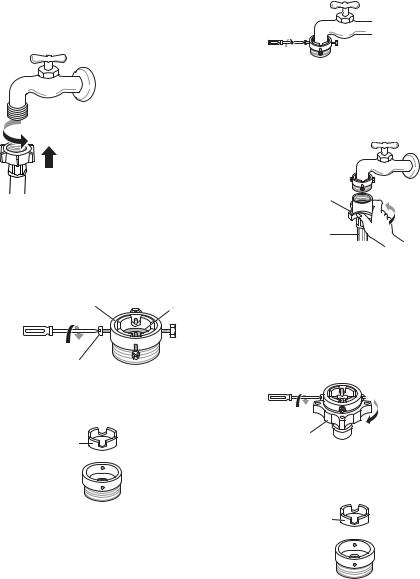
Connecting Hose to Water Tap
Connecting Screw-Type Hose to Tap with Thread
Screw the hose connector onto the water supply tap.
EN
3 Push the adapter onto the end of the tap so that the rubber seal forms a watertight connection. Tighten the four fixing screws.
4 Push the supply hose vertically upwards so that the rubber seal within the hose can
adhere completely to the tap and then tighten it by screwing it to the right.
Connecting Screw-Type Hose to Tap Without Thread
1 Loose the four fixing screws.
Upper |
Rubber |
connector |
seal |
Fixing screw |
|
2 Remove the guide plate if the tap is too large to fit the adapter.
Guide plate
Plate
Supply
hose
Connecting One Touch Type Hose to Tap Without Thread
1 Unscrew the adapter ring plate and loose the four fixing screws.
Ring plate
2 Remove the guide plate if the tap is too large to fit the adapter.
Guide plate
16
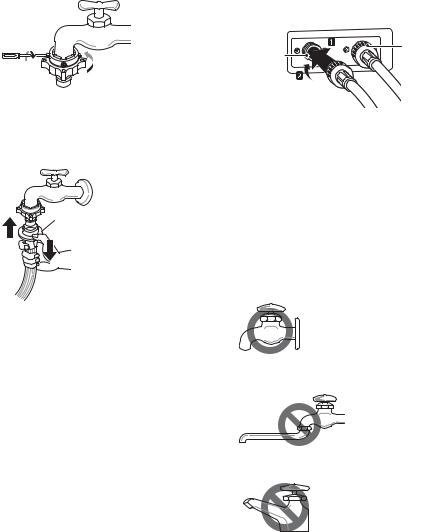
3 Push the adapter onto the end of the tap so that the rubber seal forms a watertight connection. Tighten the four fixing screws and the adapter ring plate.
4 Pull the connector latch plate down, push the supply hose onto the adapter, and release the connector latch plate. Make sure the adapter locks into place.
Latch plate
NOTE
••Before connecting the supply hose to the water tap, turn on the water tap to flush out foreign substances (dirt, sand, sawdust, and etc.)
in the water lines. Let the water drain into a bucket, and check the water temperature.
EN
Connecting Hose to Appliance
Attach the hot water line to the hot water supply on the back of the washer. Attach the cold water line to the cold water supply on the back of the washer.
Cold water |
Hot water |
supply |
|
supply |
|
NOTE
••After completing connection, if water leaks from the hose, repeat the same steps. Use the most conventional type of tap for the water supply. In case the tap is square or too big, remove the guide plate before inserting the tap into the adaptor.
Using the Horizontal Tap
Horizontal tap
Extension tap
Square tap
17
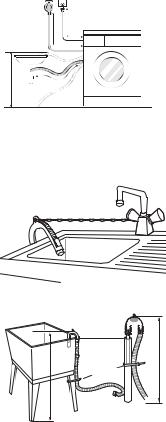
EN
Installing the Drain Hose
••The drain hose should not be placed higher than 100 cm above the floor. Water in the appliance may not drain or may drain slowly.
••Securing the drain hose correctly will protect the floor from damage due to water leakage.
••If the drain hose is too long, do not force it back into the appliance. This will cause abnormal noise.
~ 100 cm
~ 145 cm
 ~ 105 cm max. 100 cm
~ 105 cm max. 100 cm
••When installing the drain hose to a sink, secure it tightly with string.
••Securing the drain hose correctly will protect the floor from damage due to water leakage.
Laundry tub
Hose retainer 
max. 100 cm
Tie strap
max. 100 cm
18

OPERATION
Using the Washing Machine
Before the first wash, select a washing programme, allow the washing machine to wash without clothing. This will remove residue and water from the drum that may have been left during manufacturing.
1 Sort laundry and load items.
••Sort laundry by fabric type, soil level, colour and load size as needed. Open the door and load items into the washing machine.
2 Add cleaning products and/or detergent and softener.
••Add the proper amount of detergent to the detergent dispenser drawer. If desired, add bleach or fabric softener to the appropriate areas of the dispenser.
3 Turn on the washing machine.
••Press the Power button to turn on the washing machine.
EN
4 Choose the desired washing cycle.
••Press the cycle button repeatedly or turn the cycle selector knob until the desired cycle is selected.
5 Begin cycle.
••Press the Start/Pause button to begin the cycle. The washing machine will agitate briefly without water to measure the weight of the load. If the Start/Pause button is not pressed within 5 minutes, the washing machine will shut off and all settings will be lost.
6 End of cycle.
••When the cycle is finished, a melody will sound. Immediately remove your clothing from the washing machine to reduce wrinkling. Check around the door seal when removing the load for small items that may be caught in the seal.
NOTE
••The button cannot be recognized when the door is open. Press again after closing the door.
19
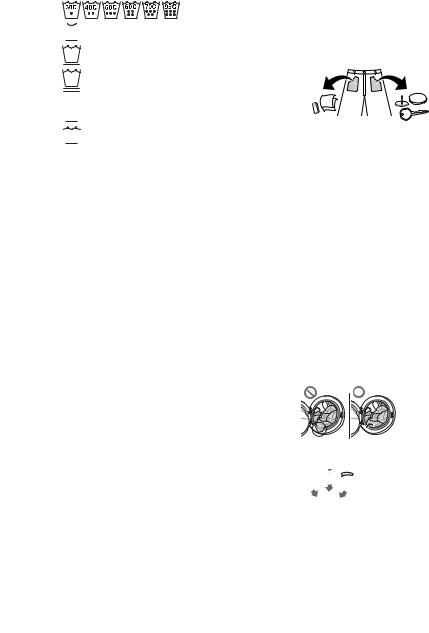
Sorting Laundry
1 Look for a care label on your clothes.
••This will tell you about the fabric content of your garment and how it should be washed.
••Symbols on the care labels.
Wash temperature

 Normal machine wash
Normal machine wash
Permanent press
Delicate

 Hand wash
Hand wash
 Do not wash
Do not wash
2 Sorting laundry.
••To get the best results, sort clothes into loads that can be washed with the same wash cycle.
••Different fabrics need to be washed at varying temperatures and spin speeds.
••Always sort dark colours from pale colours and whites. Wash separately as dye and lint transfer can occur causing discolouration of white and pale garments. If possible, do not wash heavily soiled items with lightly soiled ones.
−−Soil (Heavy, Normal, Light) :
Separate clothes according to amount of soil.
−−Colour (White, Lights, Darks): Separate white fabrics from coloured fabrics.
−−Lint (Lint producers, Collectors): Wash lint producers and lint collectors separately.
EN
3 Caring before loading.
••Combine large and small items in a load. Load large items first.
••Large items should not be more than half the total wash load. Do not wash single items. This may cause an unbalanced load. Add one or two similar items.
••Check all pockets to make sure that they are empty. Items such as nails, hair clips, matches, pens, coins and keys can damage both your washing machine and your clothes.
••Close zippers, hooks and strings to make sure that these items don’t snag on other clothes.
••Pre-treat dirt and stains by brushing a small amount of detergent dissolved water onto stains to help lift dirt.
CAUTION
••Check inside the drum and remove any items from a previous wash.
20
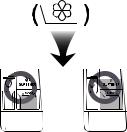
Adding Cleaning Products
Detergent Dosage
••Detergent should be used according to the instruction of the detergent manufacturer and selected according to type, colour, soiling of the fabric and washing temperature.
••If too much detergent is used, too many suds can occur and this will result in poor washing results or cause heavy load to the motor.
••If you wish to use liquid detergent follow the guidelines provided by the detergent manufacturer.
••You can pour liquid detergent directly into the main detergent drawer if you are starting the cycle immediately.
••Do not use liquid detergent if you are using Time delay, or if you have selected Pre Wash, as the liquid may harden.
••If too many suds occur, reduce the detergent amount.
••Detergent usage may need to be adjusted for water temperature, water hardness, size and soil level of the load. For best results, avoid oversudsing.
••Refer to the label of the clothes, before choosing the detergent and water temperature.
••When using the washing machine, use designated detergent for each type of clothing only:
−−General powdered detergents for all types of fabric
−−Powdered detergents for delicate fabric
−−Liquid detergents for all types of fabric or designated detergents only for wool
••For better washing performance and whitening, use detergent with the general powdered bleach.
••Detergent is flushed from the dispenser at the beginning of the cycle.
EN
NOTE
••Do not let the detergent harden. Doing so may lead to blockages, poor rinse performance or odour.
••Full load : According to manufacturer’s recommendation.
••Part load : 3/4 of the normal amount
••Minimum load : 1/2 of full load
Adding Detergent and Fabric
Softener
Adding Detergent
••Main wash only → 
••Pre wash+Main wash → 


NOTE
••Too much detergent, bleach or softener may cause an overflow.
••Be sure to use the appropriate amount of detergent.
Adding Fabric Softener
••Do not exceed the maximum fill line. Overfilling can cause early dispensing of the fabric softener, which may stain clothes. Close the dispenser drawer slowly.
21

••Do not leave the fabric softener in the detergent drawer for more than 2 days (Fabric softener may harden).
••Softener will automatically be added during the last rinse cycle.
••Do not open the drawer when water is being supplied.
••Solvents (benzene, etc.) must not be used.
NOTE
••Do not pour fabric softener directly on the clothes.
Adding Water Softener
••A water softener, such as anti-limescale can be used to cut down on the use of detergent in areas with high water hardness level.
••Dispense according to the amount specified on the packaging. First add detergent and then the water softener.
EN
Using Tablet
1 Open the door and put tablets into the drum.
2 Loaddoor. the laundry into the drum and close the
22
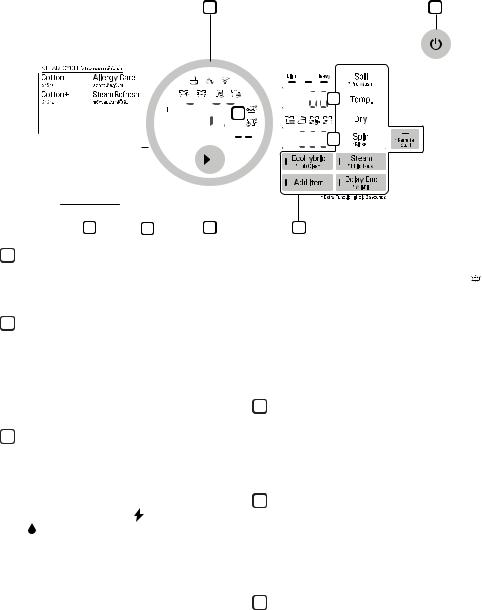
Control Panel
Z
 [
[
 ]
]



 Y
Y

 h
h
1Power Button
••Press the Power button to turn the washing machine on.
2Start/Pause Button
••This Start/Pause button is used to start the wash cycle or pause the wash cycle.
••If a temporary stop of the wash cycle is needed, press the Start/Pause button.
EN
X




 i
i




 j
j
\
•• : The display shows estimate time remaining. While the size of the load is being calculated automatically, blinking or ‘Detecting’ appears.
: The display shows estimate time remaining. While the size of the load is being calculated automatically, blinking or ‘Detecting’ appears.
•• : The water temperature is displayed when pressing the Temp. button.
: The water temperature is displayed when pressing the Temp. button.
•• : The spin speed level is displayed when pressing the Spin button.
: The spin speed level is displayed when pressing the Spin button.
3Display
••The display shows the settings, estimated time remaining, options, and status messages. When the product is turned on, the default settings in the display will illuminate.
••The estimated energy( ) and water( ) consumptions are displayed before
washing and the actual consumptions after washing.
4Programme Button
••Programmes are available according to laundry type.
••Lamp will light up to indicate the selected programme.
5Options
••This allows you to select an additional programme and will light when selected.
••Use these buttons to select the desired programme options for the selected cycle.
6 Wash+Dry( )
••( ) indicates the drying capacity, which varies on the models.
23

EN
Programme Table
Washing Programme
Programme |
Description |
Fabric Type |
Proper Temp. |
Maximum |
|
Load |
|||||
|
|
|
|
||
|
Provides better |
|
|
|
|
Cotton |
performance by |
|
40 °C |
|
|
combining various drum |
Coloured fast garments |
(Cold to 95 °C) |
|
||
|
|
||||
|
motions. |
(shirts, nightdresses, |
|
|
|
|
Provides optimised |
pajamas, etc.) and |
|
Rating |
|
|
washing performance |
normally soiled cotton |
60 °C |
|
|
Cotton+ |
for large amount |
load (underwear). |
|
||
(Cold to 60 °C) |
|
||||
|
of laundry with less |
|
|
||
|
|
|
|
||
|
energy consumption. |
|
|
|
|
Easy Care |
Suitable for casual |
Polyamide, acrylic, |
40 °C |
|
|
shirts that do not need |
5 kg |
||||
polyester. |
(Cold to 60 °C) |
||||
|
ironing after washing. |
|
|||
|
|
|
|
||
|
|
Various kind of fabrics |
|
|
|
Mixed Fabric |
Enables various |
except special garments |
40 °C |
|
|
fabrics to be washed |
(silk/delicate, sports wear, |
|
|||
(Cold to 40 °C) |
|
||||
|
simultaneously. |
dark clothes, wool, duvet/ |
|
||
|
|
|
|||
|
|
curtains). |
|
4.5 kg |
|
|
Helps to remove |
Cotton, underwear, pillow |
|
|
|
Allergy Care |
allergens such as |
60 °C |
|
||
covers, bed sheets, baby |
|
||||
house mites, pollen, |
(60 °C to 95°C) |
|
|||
|
and cat fur. |
wear |
|
|
|
|
|
|
|
||
|
Enables to wash wool |
Machine washable |
|
|
|
Wool |
fabrics. (Use detergent |
30 °C |
|
||
woolens with pure new |
3 kg |
||||
for machine-washable |
(Cold to 40 °C) |
||||
|
wool only. |
|
|||
|
woolens). |
|
|
||
|
|
|
|
||
|
Helps to remove |
|
|
|
|
|
wrinkles within 20 mins |
|
|
|
|
Steam |
with steam (Clothes |
Cotton mixed, polyester |
|
|
|
may be wet. You can |
mixed dress shirts, |
No choice |
3 items |
||
Refresh |
|||||
put them on after hang |
blouses |
|
|
||
|
|
|
|||
|
out to dry for 10‒30 |
|
|
|
|
|
min). |
|
|
|
24

EN
Programme |
Description |
Fabric Type |
Proper Temp. |
Maximum |
|
Load |
|||||
|
|
|
|
||
Outdoor |
Suitable for sports wear |
Coolmax, gore-tex, fleece |
30 °C |
|
|
such as jogging clothes |
and sympatex |
(Cold to 40 °C) |
|
||
|
and running wear. |
|
|
3 kg |
|
Quick 30 |
Provides fast washing |
Lightly soiled colour |
20 °C |
||
|
|||||
time for small loads and |
|
||||
laundry. |
(Cold to 40 °C) |
|
|||
|
lightly soiled clothes. |
|
|
|
|
|
For hand and machine |
|
|
|
|
|
washable delicate |
|
|
|
|
Gentle Care |
clothes such as |
Wool, hand washable |
20 °C |
|
|
washable wool, lingerie, |
clothes, delicate, easily |
1.5 kg |
|||
(Cold to 30 °C) |
|||||
|
dresses etc. (Use |
damaged laundry. |
|
||
|
|
|
|||
|
detergent for machine |
|
|
|
|
|
washable woolens). |
|
|
|
|
|
Provides a nonstop |
|
|
|
|
Wash+Dry |
process of washing |
A small amount of laundry |
40 °C |
8 kg |
|
and drying in the same |
which can be dried. |
(Cold to 95 °C) |
|||
|
|
||||
|
cycle. |
|
|
|
Download For downloadable programmes. If you did not download any programmes, the Cycle default is Rinse+Spin.
••Water Temperature: Select the appropriate water temperature for chosen wash programme. Always follow garment manufacturer’s care label or instructions when washing.
NOTE
••Neutral detergent is recommended.
25

EN
Drying Programme
Programme |
|
Description |
Fabric Type |
Maximum |
|
|
Load |
||||
|
|
|
|
|
|
|
|
|
For cottons. Select this |
Cotton or linen fabrics such |
|
|
|
|
programme to reduce cycle |
|
|
Normal ( |
) |
|
as cotton towels, t-shirts, |
Rating |
|
|
time and energy usage during |
||||
|
|
|
the dry cycle. |
and linen laundries. |
|
|
|
|
|
|
|
|
|
|
For easy iron, finish drying in |
Cotton or linen fabrics, |
|
Iron ( |
) |
|
ready to iron at the end of |
Rating |
|
|
damp condition. |
||||
|
|
|
|
programme. |
|
|
|
|
|
Easy care textiles, synthetic |
|
Low Temp. ( |
|
) |
For less clothes damage, it |
fabrics suitable for Easy |
3.5 kg |
|
dries in low temperature. |
Care, Mix programme |
|||
|
|
|
|
washable clothes |
|
Time 30 min. ( |
) |
You can change the drying |
|
0.5 kg |
|
|
|
|
|
|
|
Time 60 min. ( |
) |
time according to the maximum |
Cotton, towel |
1 kg |
|
|
|
load. |
|
|
|
Time 120 min. ( |
) |
|
3 kg |
||
NOTE
••Select maximum selectable spin speed of washing programme to ensure drying results.
••Where the amount of laundry to be washed and dried in one programme does not exceed the maximum weight permitted for the drying programme, washing and drying in one continuous sequence is recommended.
26

|
|
|
|
|
|
|
EN |
|
Extra Options |
|
|
|
|
|
|
|
|
|
|
|
|
|
|
|
|
|
Programme |
Pre |
Steam |
Steam |
Delay |
Rinse+ |
EcoHybrid |
Dry |
|
Wash |
Wash |
Softener |
End |
|||||
|
|
|
|
|||||
Cotton |
● |
● |
● |
● |
● |
|
● |
|
Cotton+ |
● |
● |
● |
● |
● |
|
● |
|
Easy Care |
● |
● |
● |
● |
● |
|
● |
|
Mixed Fabric |
● |
● |
● |
● |
● |
|
● |
|
Allergy Care |
|
●* |
|
● |
● |
|
● |
|
Wool |
|
|
|
● |
● |
|
|
|
Steam Refresh |
|
●* |
|
|
|
|
|
|
Outdoor |
|
|
|
● |
● |
|
● |
|
Quick 30 |
|
|
|
● |
● |
|
● |
|
Gentle Care |
|
|
|
● |
● |
|
|
|
Wash+Dry |
● |
● |
|
● |
● |
● |
●* |
* : This option is automatically included in the cycle and can not be deleted.
27

EN
Operating Data
Programme |
Max RPM |
|
1600 |
||
|
||
Cotton |
1600 |
|
Cotton+ |
1600 |
|
Easy Care |
1200 |
|
Mixed Fabric |
1600 |
|
Allergy Care |
1600 |
|
Wool |
800 |
|
Steam Refresh |
- |
|
Outdoor |
800 |
|
Quick 30 |
1600 |
|
Gentle Care |
800 |
|
Wash+Dry |
1600 |
28

Option Programme
Delay End
You can set a time delay so that the washing machine will start automatically and finish after a specified time interval.
1 Press the Power button.
2 Select a washing programme.
3
4
NOTE
••The delay time is the time to the end of the programme, not the start. The actual running time may vary due to water temperature, wash load and other factors.
••To cancel the Time Delay function, the power button should be pressed.
••Avoid using liquid detergent for this option.
EcoHybrid
Use for air condensing dry without water consumption used for condensing.
1
2 Select a drying programme.
3 Press the EcoHybrid button.
4 Press the Start/Pause button.
NOTE
••Available with the Normal or Iron programme.
EN
Steam (Optional)
Steam Wash features enhanced washing performance with low energy consumption. Steam Softener sprays steam after a spinning cycle to reduce creases and make the laundry fluffy.
1 Press the Power button.
2 For Steam Wash option, select steam programmes. For Steam Softener option, select Cotton or Cotton+, Mixed Fabric, Easy Care.
3 The following programme is selected depending on the number of times you press the Steam button.
••Once: Steam Wash
••Twice: Steam Softener
••Three times: Steam Wash and Steam Softener
4 Press the Start/Pause button.
Steam Wash (
 )
)
••For heavily stained clothes, underwear or baby clothes.
••Available with the Cotton, Cotton+, Mixed Fabric, Easy Care, Allergy Care, Steam Refresh, Wash+Dry programmes.
••Do not use Steam Wash for easily discoloured clothes and delicates such as wool, silk.
Steam Softener (
 )
)
••Good to soften and fluff fabrics after air drying.
••Available with the Cotton, Cotton+, Mixed Fabric, Easy Care programmes.
••Do not use Steam Softener for easily discoloured clothes and delicates such as wool, silk.
••Depending on the kind of fabric, softening performance may be different.
29

Add Item
Laundry can be added or removed after the washing programme is started.
1 Press the Add Item button when the LED is turned on.
2 Open the door after door lock is released.
3 Add or remove laundry.
4 Press the Start/Pause button again to continue the cycle. The cycle continues automatically.
NOTE
••For safety reasons, the door remains locked when the water level or temperature is high. It is not possible to add laundry during this time.
••If the water temperature in the drum is high, wait until it cools down.
 CAUTION
CAUTION
••When adding laundry, make sure to completely push it into the drum. If laundry gets stuck in the door latch hole, the rubber packing may be damaged, causing water leakage and malfunction.
••Forcing the door open may cause part damage, destruction, or safety problems.
••If you open the door while there are a lot of suds and water in the drum, the suds or water may flow, causing burn injury or wet floor.
EN
Remote Start
Use a smart phone to control your appliance remotely. You can also monitor your cycle operation so you know how much time is left in the cycle.
NOTE
••You must first connect to a gateway and register your appliance in order to use the Remote Start function. (Refer to 'SMART FUNCTIONS')
To Use Remote Start:
1 Press the Power button.
2 Put the laundry in drum.
3 Press and hold Remote Start button for 3 seconds to enable Remote Start function.
4 Start a cycle from the LG SmartThinQ application on your smart phone.
NOTE
••If you do not start your appliance, it will wait to start a cycle until you turn off your appliance from the application or disable the Remote Start function.
••When Remote Start is turned on, the door is automatically locked.
To Disable Remote Start:
When the Remote Start is activated, press and hold Remote Start button for 3 seconds.
NOTE
••If the door is open, Remote Start is disabled.
30
